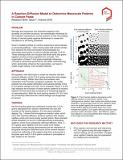| dc.description.abstract | Strength and toughness, two important aspects of the durability of concrete structures, are dramatically influenced by the material’s nanotexture, but the question of how the building blocks of cement paste organize themselves to create this nanotexture is still being answered. Recent modelling efforts by CSHub researchers demonstrated a convincing pathway. Upon mixing water with cement clinker, ions dissolve into the pore solution and precipitate out nanometer-sized grains of calcium-silicate-hydrates (C-S-H). These building blocks are the glue that binds sand and gravel together and the primary ingredient for concrete. The organization of these C-ˇS-ˇH grains drastically influences concrete’s mechanical performance. By better understanding which parameters influence this organization, we hope to create longer-lasting, more durable materials. | en_US |
